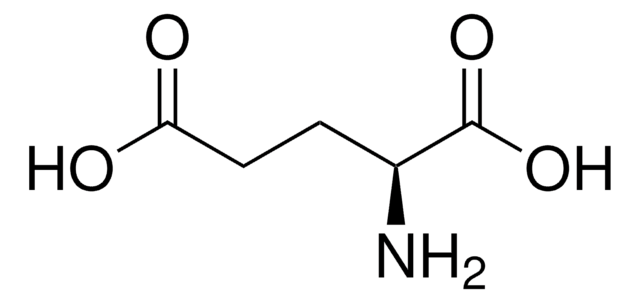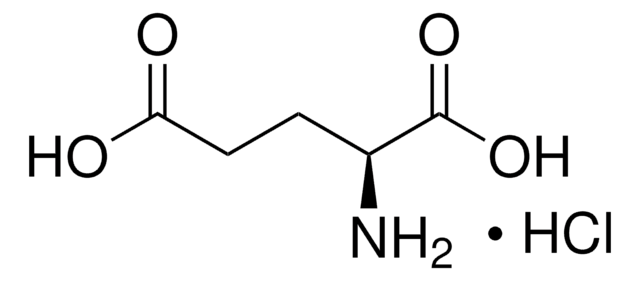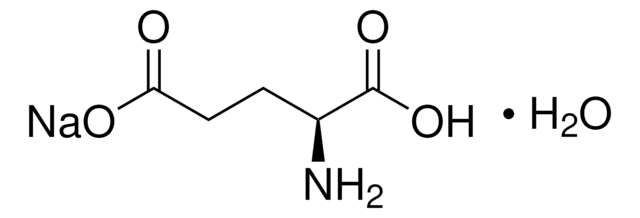G1251
L-Glutamic acid
≥99% (HPLC), suitable for microbiological culture, ReagentPlus®
Synonym(s):
(S)-2-Aminopentanedioic acid, Glu
About This Item
Recommended Products
product name
L-Glutamic acid, ReagentPlus®, ≥99% (HPLC)
agency
suitable for SM 5210
Quality Level
product line
ReagentPlus®
assay
≥99% (HPLC)
form
powder
technique(s)
microbiological culture: suitable
color
white to off-white
mp
205 °C (dec.) (lit.)
solubility
1 M HCl: soluble 100 mg/mL
density
1.54 g/cm3 at 20 °C
cation traces
C: 40.4-41.2%
N: 9.2-9.8%
SMILES string
N[C@@H](CCC(O)=O)C(O)=O
InChI
1S/C5H9NO4/c6-3(5(9)10)1-2-4(7)8/h3H,1-2,6H2,(H,7,8)(H,9,10)/t3-/m0/s1
InChI key
WHUUTDBJXJRKMK-VKHMYHEASA-N
Gene Information
human ... CCR2(1231) , GRIA1(2890) , GRIA2(2891) , GRIA4(2893) , GRIK2(2898) , GRIK3(2899) , GRIK5(2901) , GRIN2B(2904) , GRM2(2912) , SLC1A1(6505) , SLC1A2(6506)
rat ... Gria1(50592) , Grik1(29559) , Grik2(54257) , Grik4(24406) , Grin2a(24409) , Grm1(24414) , Grm2(24415) , Grm3(24416) , Grm4(24417) , Grm5(24418) , Grm6(24419) , Grm7(81672) , Slc1a2(29482)
Looking for similar products? Visit Product Comparison Guide
Related Categories
Application
Biochem/physiol Actions
Glutamine serves as a source of energy for rapidly dividing cells comprising lymphocytes, enterocytes, macrophages and tumors. Glutamine mediates protein turnover via cellular mTOR (mammalian target of rapamycin) signaling. It is also known to be associated with the inhibition of apoptosis.
Legal Information
wgk_germany
WGK 1
flash_point_f
Not applicable
flash_point_c
Not applicable
ppe
Eyeshields, Gloves, type N95 (US)
Certificates of Analysis (COA)
Search for Certificates of Analysis (COA) by entering the products Lot/Batch Number. Lot and Batch Numbers can be found on a product’s label following the words ‘Lot’ or ‘Batch’.
Already Own This Product?
Find documentation for the products that you have recently purchased in the Document Library.
Customers Also Viewed
Chromatograms
application for HPLCOur team of scientists has experience in all areas of research including Life Science, Material Science, Chemical Synthesis, Chromatography, Analytical and many others.
Contact Technical Service







